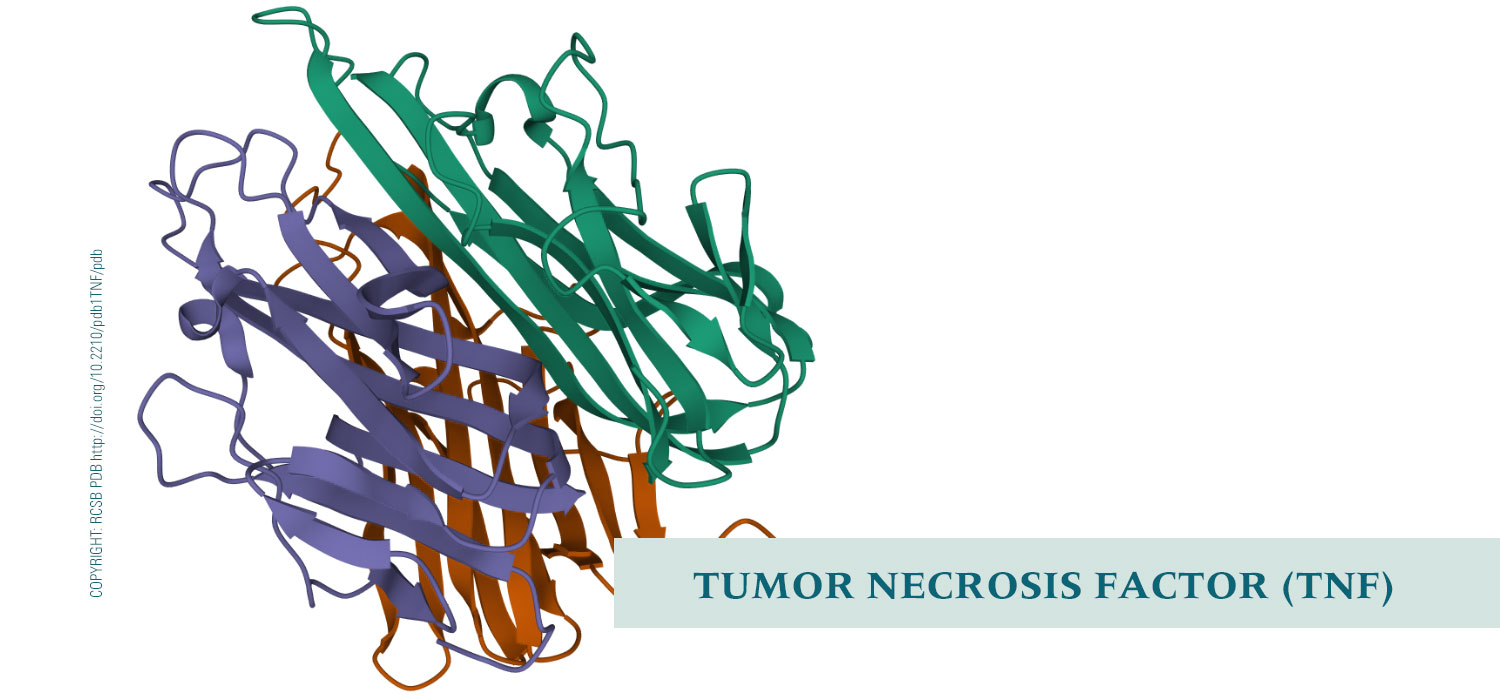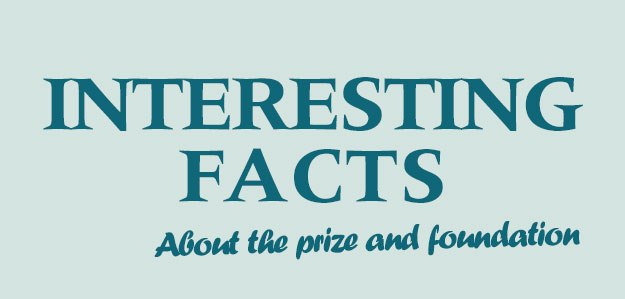- GU Home
- Paul Ehrlich Foundation
- Interesting Facts
- tumor necrosis factor (TNF)

The translation of basic medical research into clinical practice rarely runs on a straight lane. Rather it mostly leads along winding roads. Sometimes even via wrong ways, as in the case of tumor necrosis factor. As its name suggests, it should have been developed into a drug for the treatment of cancer. Instead, it became the target molecule of drugs that revolutionized the treatment of rheumatoid arthritis.
The story begins in 1891, when American physician William Coley injected a bacterial extract directly into the tumor of a moribund cancer patient. The man lived for another eight years. In patients with soft tissue sarcomas, Coley achieved cure rates of ten percent in this way. The reason for this remained "one of the best-known enigmas of cancer biology“ for a long time, as cancer researcher Lloyd Old wrote in 1975 at the beginning of the publication in which he solved this enigma: The bacterial toxins stimulate, especially in the macrophages of the immune system, the release of a protein that destroys the tumor. Old called it tumor necrosis factor.
A dangerous wonder weapon
In the following decade, hopes that tumor necrosis factor (TNF) could become a cure for cancer grew immeasurably. These were the years of "interferon fever," in which messenger molecules of the immune system were hyped up as miracle weapons, and not only by tabloids. The only thing that seemed to matter was to produce such proteins in sufficient quantities. Genetic engineering, which had just been invented, would make this possible – and it did. At Genentech, the world's first genetic engineering company founded in 1976, a team led by Bharat Aggarwal succeeded in producing recombinant TNF in 1984.
In the meantime, however, Anthony Cerami and David Wallach gained insights that called into question TNF's suitability as a cancer therapeutic. Both had approached the molecule from different angles since the mid-1970s, unaware that their object of research was the same. While searching for signaling molecules of programmed cell death, Wallach had come across a molecule he called cytotoxin. He found that it was identical to TNF. Cerami researched the causes of cachexia in inflammatory diseases such as tuberculosis or sepsis and found a molecule he called cachectin as one trigger. In 1985 - thanks to the availability of genetically engineered TNFs - he and his collaborator Bruce Beutler (who was awarded a Nobel Prize in 2011 for his discoveries on innate immunity) discovered that TNF and cachectin were identical - a shock for all those who wanted to develop TNF into a cancer therapeutic, as Charles Dinarello pointed out in his eulogy for Cerami and Wallach.
Two strategies of blockade
It was apparently more promising to develop inhibitors that stop the inflammatory processes that TNF triggers. Two strategies were worth considering to reach this goal: Using monoclonal antibodies to block the messenger substance directly - this was a suggestion Cerami had already made in 1981. Or intercepting it with a molecule similar to the receptors through which it mediates its signals in body cells. Wallach had succeeded in isolating soluble forms of these TNF receptors from urine in 1989, which provided the impetus for developing the fusion protein etanercept. However, the first clinical trial of TNF blockade in patients not suffering from sepsis was undertaken by Mark Feldmann and Ravinder Maini in London. This provided the impetus for the development of the antibody infliximab.
The London researchers had previously detected persistently high levels of TNF and other pro-inflammatory cytokines in cell cultures from joint biopsies of rheumatoid arthritis patients. This was surprising, because normally these substances are only released for a maximum of one to two days during an inflammatory reaction. It was also surprising that TNF blockade alone could also inhibit the synthesis of all other cytokines in cell culture. Would anti-TNF therapy work against rheumatism? Everything was in favor for testing this hypothesis clinically.
An initially hesitant industry
The only problem was that the pharmaceutical industry, which at the time was focused on treating sepsis, showed no interest. If an American biotech company had not hired one of Feldmann's colleagues as its chief scientific officer, TNF blockers might have arrived in the clinic much later. But Feldmann and Maini were able to use an antibody developed by this company in a proof-of-concept study to treat 20 patients with severe rheumatoid arthritis who were no longer helped by conventional drugs. The success was astonishing: all 20 probands responded to the treatment, and in many of them the swollen joints even decongested completely within six weeks. It was not until Feldmann presented these results at a conference in the fall of 1992 (long before they were published) that many companies jumped on the concept.
At the turn of the century, the first TNF blockers were approved, not only for rheumatism, where they are usually given in combination with disease-modifying drugs, but gradually also for other inflammatory autoimmune diseases. Even if they do not bring about a cure and are far from helping all patients permanently, they have taken the treatment of rheumatoid arthritis, Crohn's disease, psoriasis and other serious illnesses to a new level. Every day, they alleviate the suffering of many millions of patients. For good reason, TNF inhibitors have been the world's top-selling drug class for years now.
CONTACT
Office Paul Ehrlich Foundation:
Friends of the Goethe University Frankfurt
Goethe-Universität Frankfurt
Campus Westend, PA-Gebäude
Theodor-W.-Adorno-Platz 1
60629 Frankfurt am Main
www.vff.uni-frankfurt.de
Managing Directors
Nike von Wersebe
Tel: 069 / 798 12234
Fax: 069 / 798 763 12234
wersebe@vff.uni-frankfurt.de
Julia Lange
Tel: 069 / 798 12452
Fax: 069 / 798 763 12452
E-Mail: lange@vff.uni-frankfurt.de
Adviser for Members & Foundations
Tina Faber
Tel: 069 / 798 17237
Fax: 069 / 798 763 17237
faber@vff.uni-frankfurt.de
Marketing
Constanze von Plato
Tel: 069 / 798 17237
Fax: 069 / 798 763 17237
vonplato@vff.uni-frankfurt.de
Science Communication
Joachim Pietzsch
Tel: 069 36007188
j.pietzsch@wissenswort.com
Bank Account
Paul Ehrlich-Stiftung
Deutsche Bank AG
IBAN: DE38500700100700083900
BIC: DEUTDEFFXXX
Donations are tax deductible.
- Studying at Goethe University
- International applicants
- Faculties
- Overview of study programmes
- Programme for refugees
- GRADE
- Goethe Business School (continuing education)
- Research at Goethe University
- Scientific news
- Goethe Welcome Center (for international researchers)
- Collaborative research projects
- Individual research
- Visiting fellowships
- Endowed chairs
- About the University
- News-in-brief
- University administration
- Campus locations
- Campus life
- University archives (German)
- Rhine-Main-Universities







